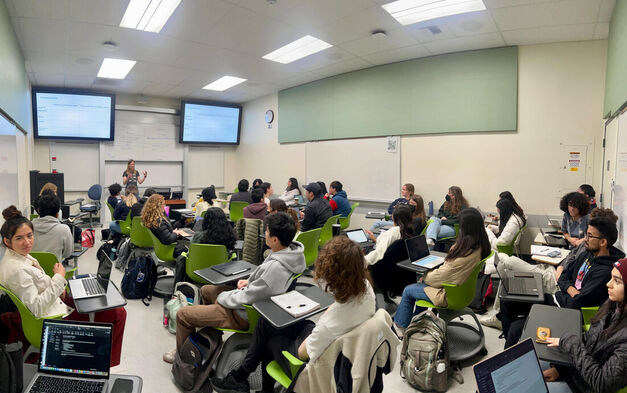|
Claire Short UC Davis graduate, Spring 2022 Major: Wildlife, Fish, and Conservation Biology I stepped hesitantly into the classroom and snuck past a handful of students who had arrived early. I felt self-conscious sitting down at the front of the room, facing 40 or so green plastic chairs arranged in haphazard rows, most of which would soon be occupied. When Becca first suggested that I give a guest lecture on animal-assisted therapy and experiment design in the class she’s teaching, I was excited. But for the past few days, I had been almost dreading this moment, although I knew that I would stop worrying when I got into the flow of the lecture. When I’m teaching, whether I’m working with humans or other animals, I become more aware of the subtle forms of communication that help me understand my students. This makes me feel more connected with those around me and keeps me in the moment. After I had been lecturing for a few minutes, the yawning commenced. Of course, college students are chronically sleep-deprived, but I felt that if I had been sufficiently engaging, they wouldn’t have been thinking about how tired they were. It reminded me of when I’m training my dog, Oliver, and he suddenly finds a fascinating smell, which was there all along but he only noticed it when the training session became boring or stressful. At that point, I would change something – perhaps increase the frequency of rewards, use a different treat, or practice something easier. But since this was my first time teaching a college class, I didn’t feel comfortable deviating from my plan. I made a mental note to incorporate more student participation near the beginning next time and hoped that the yawning would cease when I started asking the students questions. Finally, I asked the students to think of possible confounding variables in a study I had described, and before I had even finished asking the question, two or three hands shot up. This surprised me because I wasn’t expecting the students to have so much life in them. I guess I was recalling half-dead chemistry and physics classes where the professors struggled to extract answers from the students’ dormant brains. It was like the difference between an animal who has been trained with positive reinforcement and one who has been trained with force-based methods. When I’m teaching Oliver a new trick, he will offer a bunch of different behaviors until he finds the right one because he’s not afraid of being wrong. A dog who’s been trained only to obey will turn off his brain and wait to be told what to do. I was glad the students were brave enough to offer me their thoughts. Many of the students’ answers were correct, but what I enjoyed the most was listening to the students who didn’t quite grasp the concept. This forced me to try to hear my own words from the perspective of someone whose perceptions differed from my own. Peering through tiny windows into other minds is part of what I love about training and teaching, whether it gives me a glimpse of what it would be like to see the world through smells, or simply to have had a different education. Ironically, this level of understanding is often reached through misunderstanding, like when I thought that my dog could pick out his stuffed monkey from the toy pile on cue, but then realized that he was actually sniffing out the toy I had recently touched. Unintentionally, he had communicated to me about how he experiences the world. Partway through the lecture, I looked down at my hand as I changed the slides, and I realized that it was not shaking. Nor was I blushing, sweating significantly, or feeling faint, all of which I had learned to expect during presentations over the years. Then I looked up at the students in their green plastic chairs, and I felt proud of them, even though they were only mine for an hour and a half. I felt proud of all of us for staying present and listening to each other, and for being brave.
6 Comments
2/12/2023 05:41:04 pm
The article reflects on the author's experience of giving a guest lecture on animal-assisted therapy and experiment design, discussing the challenges they faced, their strategies for engaging the students, and their reflections on the importance of positive communication in teaching and learning.
Reply
9/18/2023 10:26:16 pm
Absolutely fascinating read! Teaching and deciphering other minds is such a crucial skill in our interconnected world. Thanks for sharing!
Reply
Leave a Reply. |
Green Care Blog
Here you can find blog posts from each Green Care Lab intern. We'll be talking about our research process, the benefits of Green Care therapy, and sharing pictures of our work. Follow along with us! Authors
All
Archives
July 2023
|



